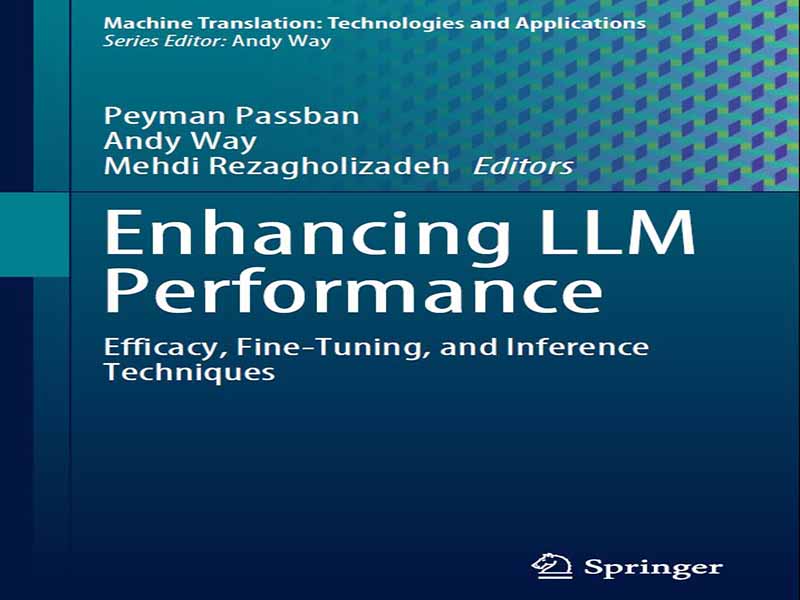- عنوان کتاب: Enhancing LLM Performance Efficacy, Fine-Tuning, and Inference Techniques
- نویسنده: Peyman Passban, Andy Way, Mehdi Rezagholizadeh
- حوزه: مدل زبانی بزرگ
- سال انتشار: 2025
- تعداد صفحه: 189
- زبان اصلی: انگلیسی
- نوع فایل: pdf
- حجم فایل: 2.87 مگابایت
این کتاب، بررسی عمیقی از دنیای پویای مدلهای زبانی بزرگ (LLM) ارائه میدهد که جنبههای مختلف تحقیق و کاربرد را در زمینههای یادگیری عمیق، درک زبان طبیعی، تحلیل تصاویر پزشکی، پیشبینی خواص پروتئینها، درک اکتساب زبان و بسیاری دیگر متحول میکنند. ما مشاهده کردهایم که LLMها نه تنها یک موضوع داغ هستند، بلکه نشاندهنده یک تغییر الگوی بالقوه اساسی هستند، تغییری که ممکن است به طلوع عصر جدیدی از تحقیقات منجر شود و بنابراین شایسته توجه ویژه است. این مدلها به دلیل مقیاس خود، چالشهای منحصر به فردی را ایجاد میکنند و نیاز به رویکردهای آموزشی و جمعآوری دادههای غیرمتعارف دارند که با روشهای سنتی متفاوت است.
فراتر از پردازش زبان پایه، LLMها قابلیتهای گستردهای را ارائه میدهند که کاوش بیشتر را میطلبد. این امر کاربرد آنها را گسترش میدهد و چالشهای بیشتری را، به ویژه در مورد عملکرد آنها به عنوان عوامل هوشمند، ایجاد میکند. سوالات مربوط به حریم خصوصی، امنیت و استفاده اخلاقی بسیار مهم هستند و ماهیت متمایز این مدلها را در مقایسه با مدلهای قبلی برجسته میکنند. همین تفاوتها و نیاز به درک جامع، ما را به تدوین این کتاب ترغیب کرد. امسال، پس از سومین کارگاه سالانه پردازش کارآمد زبان طبیعی و گفتار،1 ما فرصتی را برای تبدیل برخی از محتوای کارگاه به قالبی منتشر شده برای بهرهگیری جامعه وسیعتر تشخیص دادیم. ما متوجه شدیم که محققان تکنیکهای کوچک اما حیاتی را برای آموزش، تنظیم دقیق، بهینهسازی و تسریع LLMها ارائه میدهند. این نوآوریهای تدریجی اما حیاتی اغلب از فرآیند انتشار سنتی، که در آن یک روش نظری در یک مقاله طولانی همراه با یک بررسی گسترده ادبیات گنجانده شده است، عبور میکنند. در عوض، محققان امروزی به ارائه راهحلهای مهندسی و پرداختن مستقیم به تکنیکهای اصلی بدون توضیحات اولیه زیاد تمایل دارند. ما احساس کردیم که مهم است این رویکرد در حال تکامل در یک کتاب مستند شود، کتابی که بتواند در اسرع وقت در این حوزه پرسرعت ظاهر شود، تا سایر متخصصان بتوانند از طیف تکنیکهای موجود در اینجا بهرهمند شوند. با انجام این کار، ما نه تنها نبوغ محققان معاصر را حفظ میکنیم، بلکه منبعی قابل اعتماد برای زبانآموزان سنتیتر که مایل به دسترسی به مطالب پیشرفته هستند، فراهم میکنیم. این امر تضمین میکند که بینشهای عملی ارزشمندی به دست آمده و در دسترس مخاطبان گستردهتری قرار گیرد. علاوه بر این، با مستندسازی این بینشها، اطمینان حاصل میکنیم که ادعاهای مهندسی با استانداردها و انتظارات علمی جامعه تحقیقاتی همسو هستند. این تعادل، اعتبار تکنیکهای ارائه شده را افزایش میدهد و گفتگوی قویتری را بین توسعهدهندگان کاربردهای عملی و محققانی که علاقهمند به افزایش درک نظری ما از نحوه عملکرد این مدلها و چگونگی افزایش اثربخشی آنها هستند، ایجاد میکند.
موضوع اصلی این کتاب، کارایی و موضوع محوری آن «مقیاس» است. به طور خاص، در این جلد، هدف ما بررسی دلایل اندازه قابل توجه LLMها، بررسی پیچیدگیهای طراحی آنها و پیامدهای ناشی از آن است. ما در مورد چالشهای بزرگی که آنها ایجاد میکنند و همچنین فرصتهای بیسابقهای که ارائه میدهند، بحث خواهیم کرد. این بحث به ملاحظات فنی مختلفی مانند آموزش مدل، انتخاب مجموعه دادهها و معماری LLMها گسترش مییابد. در فصل مقدماتی اول، نقشه راهی برای سفر پیش رو ترسیم میکنیم و جزئیات آنچه خوانندگان میتوانند از هر بخش و فصل بعدی کتاب انتظار داشته باشند را شرح میدهیم. علاوه بر این، ما اصول اولیه لازم برای درک LLM ها را ارائه میدهیم و تضمین میکنیم که خوانندگان، صرف نظر از دانش قبلی خود، پایه محکمی برای کاوش مفاهیم پیشرفتهتر در سراسر کتاب داشته باشند. فصلهای بعدی از جزئیات (گاهی اوقات بسیار عمیق) طفره نمیروند، زیرا تشریح پیچیدگیهای LLM ها برای کمک به درک این الگوی جدید بسیار مهم است.
این کتاب رویکردی مستقیم و متمرکز را اتخاذ میکند و عمداً وزن کمتری به مرور ادبیات سنتی و شرح پیشینه میدهد تا بلافاصله با تکنیکهای پیشنهادی و جزئیات مرتبط درگیر شود. این کتاب برای مخاطبان متنوعی، از جمله دانشجویان، متخصصان و دانشمندان و مهندسان جوان و ارشد، چه در دانشگاه و چه در صنعت، تهیه شده است. این کتاب که برای ارائه به طیف گستردهای از خوانندگان طراحی شده است، از کسانی که به دنبال بینش فنی دقیق در مورد عملکرد LLM ها هستند تا کسانی که علاقهمند به درک پیامدهای گستردهتر این مدلها در زمینههای عملی و نظری هستند را در بر میگیرد. این کتاب با حفظ تعادل دقیق بین توضیحات فنی عمیق و بحثهای کلی، قصد دارد هم قابل فهم و هم ارزشمند باشد و به سرعت در جهت غنیسازی دانش و درک خواننده از LLMها بدون پیشفرض گرفتن دانش قبلی گسترده در این زمینه حرکت کند.
This book provides an in-depth investigation of the dynamic world of large language models (LLMs), which are revolutionizing various facets of research and application within the fields of deep learning, natural language understanding, medical image analysis, predicting the properties of proteins, understanding language acquisition, and many others. We have observed that LLMs not only represent a hot topic but signify a potentially fundamental paradigm shift, one which may lead to the dawn of a new era of research and so merits significant attention. These models pose unique challenges due to their scale, requiring unconventional training and data collection approaches that differ from traditional methods.
Beyond basic language processing, LLMs offer expanded capabilities that warrant further exploration. This broadens their utility and introduces additional challenges, particularly concerning their operation as intelligent agents. Questions of privacy, security, and ethical usage are paramount and highlight the distinct nature of these models compared to their predecessors. It is these differences and the need for a comprehensive understanding that inspired us to compile this book.
This year, following the third annual workshop on Efficient Natural Language and Speech Processing,1 we recognized the opportunity to transform some of the work-shop’s content into a published format for the benefit of the broader community. We realized that researchers provide small but vital techniques to train, fine-tune, optimize, and accelerate LLMs. These incremental but crucial innovations often bypass the traditional publication process, where a theoretical method is enshrouded in a lengthy paper accompanied by an extensive literature review. Instead, today’s researchers lean towards presenting engineering solutions and diving directly into the main techniques without much preliminary exposition. We felt it important that this evolving approach be documented in a book, and one which could appear as quickly as possible in this fast-moving area, so that other practitioners could benefit from the range of techniques contained herein. By doing so, we not only preserve the ingenuity of contemporary researchers but also provide a reliable resource for more traditional learners yet wish to access cutting-edge material. This ensures that valuable practical insights are captured and made accessible to a wider audience. Additionally, by documenting these insights, we make sure that the engineering claims align with the scientific standards and expectations of the research commu-nity. This balance enhances the credibility of the techniques presented and fosters a more robust dialogue between developers of practical applications and researchers interested in adding to our theoretical understanding of how these models work, and how they can be made to work more effectively.
The main theme of this book is efficiency and the pivotal topic is “scale”. More specifically, in this volume, we aim to examine the reasons behind the substantial size of LLMs, investigate the intricacies of their design and the consequent implications. We will discuss the formidable challenges they pose, as well as the unprecedented opportunities they offer. The discussion extends to various technical considerations such as model training, selection of data sets, and the architecture of LLMs. In the first introductory chapter, we lay out a roadmap for the journey ahead, detailing what readers can expect from each subsequent section and chapter of the book. Additionally, we provide the basic fundamentals necessary to understand LLMs, ensuring that regardless of their prior knowledge, readers have a solid foundation from which to explore more advanced concepts throughout the book. The following chapters will not shy away from (sometimes quite deep) detail, as dissecting the intricacies of LLMs is critical to aid understanding of this new paradigm.
This book adopts a direct and focused approach, intentionally putting slightly less weight on traditional literature review and background exposition to immedi-ately engage with proposed techniques and relevant details. It is crafted for a diverse audience, including students, practitioners, and both junior and senior scientists and engineers, whether in academia or industry. Designed to cater to a broad spectrum of readers, it ranges from those seeking detailed technical insights into the workings of LLMs to those interested in understanding the broader implications of these models in practical and theoretical contexts. By maintaining a careful balance between in-depth technical explanations and overarching discussions, this book aims to be both acces-sible and valuable, swiftly moving to enrich the reader’s knowledge and appreciation of LLMs without presupposing extensive prior knowledge of the field.
این کتاب را میتوانید از لینک زیر بصورت رایگان دانلود کنید:
Download: Enhancing LLM Performance Efficacy, Fine-Tuning, and Inference Techniques




































نظرات کاربران